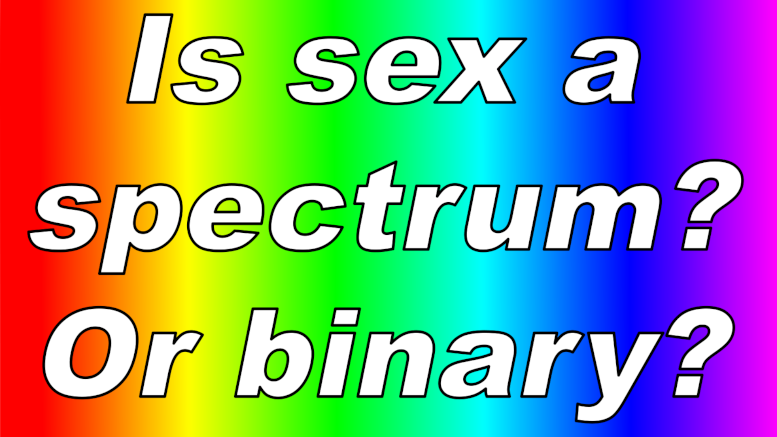Is sex a spectrum? Or binary?
At least since reruns of the Wizard of Oz were shown on colour television, the rainbow has been a metaphor for a spectrum of diversity. As any home decorator knows, there are a vast number of possible colour combinations, as many as we care to name, and when we run out of names we can use ever larger numbers to distinguish one colour of the rainbow from another, in much the same way as astronomers did when they ran out of names for stars in the universe.
It's unhelpful that the rainbow metaphor has been carried over from sexuality to the debate about sex and gender, as it presents us with wholly misleading ideas. An infographic in a Scientific American blog post from 2017 entitled 'Visualizing sex as a spectrum', often cited in the transgender debate, illustrates the problem neatly. In a classic case of 'fit the facts to the theory', a spectrum of possible sexes ranging from extremes of typical female to typical male is displayed with a multicoloured header ranging from mint green through mango yellow to fuchsia pink.
That infographic is useful for explaining the limited number of known differences of sex development (DSDs) and whether an individual identifying as intersex is likely to appear more male or more female, but it falls down when used to explain the sexes of the human race as a whole. The fact that the rainbow colours bear no relation to the data in the infographic doesn't seem to matter if we want people to go away with a strong impression that yes indeed, sex is a spectrum.
As transgender academic R.W. Connell noted in the book 'Masculinities', the metaphors that we use shape our reading of the evidence, and hence our understanding. Unfortunately, the rainbow metaphor for sex is at best wishful thinking, and at worst a deliberate attempt to impose a biologically determined model of gender diversity which is ultimately conservative.
The spectrum of light visible to humans is nothing like sex. To begin with, any hue on the spectrum of light can be created using combinations of the three familiar primary colours of red, green and blue. Perhaps you're looking at this on a 24-bit digital display which can create more than 16 million colours based on this principle. These colours can be made using just one or two of the three primary colours, all three, or none at all in the case of pure black.
Sex, on the other hand, has just two primaries in the X and Y chromosomes. We can have two X's making us a typical female, we can have both X and Y making us a typical male, or in relatively rare and special cases we can have certain combinations or mosaics which cause differences in development. There are also various known differences of sex development in chromosomally typical males and females. It doesn't appear that we can have zero sex chromosomes in total, or other combinations which just don't work to create a human to the best of our knowledge, such as YY. The range of possibilities for sex is actually very limited.
While we can change our appearance and modify sexual characteristics using hormones and surgery, we can't do anything to choose our place on, or move ourselves along, this purported spectrum. Chromosomes are for life.
Despite some cultures referring to transgender people as a third sex, we don't have a third sex chromosome, such as a Z chromosome for instance. Rather than a roll of three dice with 256 sides each, like the continuous spectrum of visible light simulated by a 24-bit digital display, biological sex is more like a single coin toss. We know that a coin mostly lands heads or tails, and only very occasionally on its side. Depending on your definition of DSD or intersex, an ambiguous result could be from every 500 times we toss the coin, to perhaps once every thousand or couple of thousand times.
Or, if we want to talk in colour, sex is a monochromatic range which is almost entirely either black or white, but with a small area of light to dark grey in between. So small, in fact, that even using the upper range of the estimate at one in 500 people growing up with a difference of sex development, the grey area is hard to see in a statistically accurate graphical representation on your screen.
That natural variation of sexual characteristics exists, as pointed out by interACT, formerly the Intersex Society of North America, does not alter the fact that most people are either male or female, with no continuity between these discrete categories. In this respect, men and women are qualitatively different, not quantitatively different. That physical education teacher at your school may have had a difference of sex development giving her elevated levels of testosterone and competitive advantage in sports, but she was not a 'percentage of male'.
Why does this matter? Because when we start to think of sex rather than gender as a colourful spectrum, a couple of things happen. Firstly, we blur the lines about what it means to be male or female in a biological sense, not for those people known to have a DSD or be intersex, but for everyone else. Even though a few people who identify as transgender discover that they have a difference of sex development or are intersex to some degree, blurring those lines is likely to produce worse health care outcomes for others, particularly for chromosomally typical transgender people who are directed to use the wrong services, or cannot access the services that they need.
Secondly, the concept of a sex spectrum has been used to conflate the wide variations and complexities in gender identity and sexuality with a biological basis. It does not help that some people use the terms sex and gender interchangeably. Yes, you can have any gender identity that you can name or choose a multi-coloured flag for, but please don't assume that this corresponds to some point on a sex spectrum. To do so would be taking us back to pre-feminist days when gender identity was welded to biology in the quote 'normal' person, and broken for everyone else. Gender non-conforming people were once considered freaks of nature, or 'inverts' to be pitied, in the language of Radclyffe Hall's 1928 transgender novel, The Well Of Loneliness.
So, if the spectrum of visible light isn't a good metaphor for sex, how about binary numbers? In a digital context, binary means more than just two forms. We can imagine the appeal of the binary/non-binary metaphor to the online world of social media, built as it is on almost unimaginably large numbers of transistors and logic circuits being switched high, represented by the number one, or low, represented by zero.
However, the binary metaphor also fails to adequately describe sex in humans, given what we know about differences of sex development and intersex variations, while non-binary is indistinct from intersex if an inherent gender essence is claimed to be the basis of an individual's authentic sex. Gender essence, the female soul, or more reductively, 'lady brain', has been described as a conservative idea wrapped in rainbow packaging, because it leads to the deeply sexist conclusion that men and women deserve gendered opportunities and the consequent economic disparities.
Gender has been far more nuanced than a synonym for sex since feminists began to define it as the roles imposed through sex-based stereotyping. When we say that non-binary identity is something real, something more than the rejection of gender stereotypes, this negative reality can only have meaning in relation to those 'others', the binary people: we are not like 'them'. Men, with their Y chromosomes switched on, are clearly the 'one' in this digital metaphor, Women, with their pair of X chromosomes, are implicitly the 'zero'.
Is it any wonder that many young women in western countries raised on positive messages about empowered womanhood, but overwhelmed by relentless masculinity nonetheless, choose to reject female identity and declare that they are not in fact women at all?
It might be more progressive to declare gender non-conformity perfectly compatible with either sex, or being intersex, but then there will be little compulsion for anyone to fix their place on the 'sex spectrum', no need to take your children to a gender identity clinic staffed with highly paid Freudians, and fewer careers to be made in post-modern academia.
There will be very little money to be made in such a proposition, which is perhaps why no one is promoting it.

